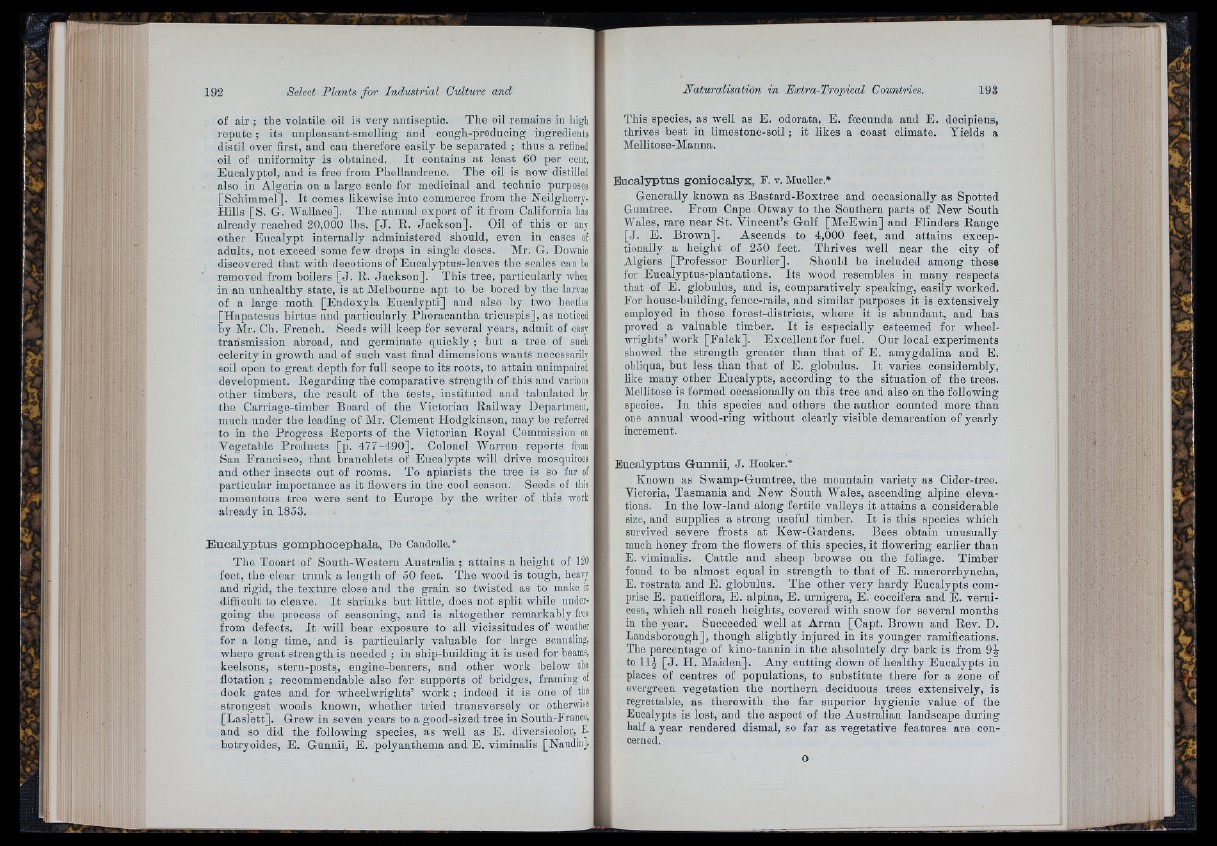
of air ; the volatile oil is very antiseptic. The oil remains in high
re p u te ; its impleasant-smelliug and cough-preducing ingredients
distil over first, and can therefore easily be separated ; thus a refined
oil of uniformity is obtained. I t contains at least 60 per cent.
Eucalyptol, and is free from Pliellandreue. The oil is now distilled
also in Algeria on a large scale for medicinal and technic purposes
[Schimmel]. I t comes likewise into eomraeree from the iSieilgherry-
Hills [S. G. Wallace]. The annual export of it from California has
already reached 20,000 lbs. [ J . R. Jackson]. Oil of this or any
other Eucalypt internally administered should, even in cases of
adults, not exceed some few drops in single doses. Mr. G. Downie
discovered tliat with decotions of Eucalyptus-leaves the scales can be
removed from boilers [ J . R. Jackson]. This tree, particularly when
in an unhealthy state, is at Melbourne apt to be bored by the larvae
of a large moth [Endoxyla Eucalypti] and also by two beetles
[Hapatesus hirtus and particularly Phoracantha trieuspis], as noticed
by Mr. Ch. French. Seeds will keep for several years, admit of easy
transmission abroad, and germinate quickly ; hut a tree of such
celerity in growth and of such vast final dimensions wants necessarily
soil open to great depth for full scope to its roots, to attain unimpaired
development. Regarding the comparative strength of this and various
other timbers, the result of the tests, instituted and tabvrlated by
the Carriage-timber Board of the Victorian Railway Department,
much under tlie leading of Mr. Clement Hodgkinson, may be referred
to in the Progress Reports of the Victorian Royal Commission on
Vegetable Products [p. 477-490]. Colonel Warren reports from
San Francisco, th a t branchlets of Eucalypts will drive mosquitoes
and other insects out of rooms. To apiarists the tree is so far of
particular importance as it flowers iu the cool season. Seeds of this
momentous tree were sent to Europe by the writer of this work
already in 1853.
E u c a ly p tu s g om p h o o e p h a la , De Candolle.*
The Tooart of South-Western Australia ; attains a height of 120
feet, the clear trunk a length of 50 feet. The wood is tough, heavy
and rigid, the texture close and the grain so twisted as to make it
difficult to cleave. I t shrinks but little, does not split while undergoing
the process of seasoning, and is altogether remarkably free
from defects. I t will bear exposure to all vicissitudes of weather
for a long time, and is particularly valuable for large soantling,
where great strength is needed ; in ship-building it is used for beams,
keelsons, stern-posts, engine-bearers, and other work below the
flotation ; reeommendable also for supports of bridges, framing of
dock gates and for wheelwrights’ work ; indeed it is one of the
strongest woods known, whether tried transversely or otherwise
[Laslett]. Grew iu seven years to a good-sized tree in South-P'rance,
and so did the following species, as well as E. diversicolor, B.
botryoides, E. Gunnii, E. polyanthema and E. viminalis [Naudin].
This species, as well as E. odorata, E. foecunda and E. decipiens,
thrives best in limestone-soil; it likes a coast climate. Yields a
Mellitose-Manna.
E u c a ly p tu s g o n io c a ly x , F. v. Mueller.*
Generally known as Bastard-Boxtree and occasionally as Spotted
Gumtree. From Cape Otway to the Southern parts of New South
Wales, rare near St. Vincent’s Gulf [McEwin] and Flinders Range
[J. E. Brown]. Ascends to 4,000 feet, and attains exceptionally
a height of 250 feet. Thrives well near the city of
Algiers [Professor Bourlier]. Should be included among those
for Eucalyptus-plantations. Its wood resembles iu many respects
that of E. globulus, and is, comparatively speaking, easily worked.
P’or house-building, fence-rails, and similar purposes it is extensively
employed in those forest-districts, where it is abundant, and has
proved a valuable timber. I t is especially esteemed for wheelwrights’
work [Falok]. Excellent for fuel. Our local experiments
showed the strength greater than th a t of E. amygdalina and E.
obliqua, but less than th a t of E. globulus. I t varies considerably,
like many other Eucalypts, according to the situation of the trees.
Mellitose is formed occasionally on this tree and also on the following
species. In this species and others the author counted more than
one annual wood-ring without clearly visible demarcation of yearly
increment.
E u c a ly p tu s G u n n ii, J . Hooker.*
Known as Swamp-Gumtree, the mountain variety as Cider-tree.
Victoria, Tasmania and New South Wales, ascending alpine elevations.
In the low-land along fertile valleys it attains a considerable
size, and supplies a strong useful timber. I t is this species which
survived severe frosts a t Kew-Gardens. Bees obtain unusually
much honey from the flowers of this species, it flowering earlier than
E. viminalis. Cattle and sheep browse on the foliage. Timber
found to he almost equal in strength to th a t of E. macrorrhyncha,
E. rostrata and E. globulus. The other very hardy Eucalypts comprise
B. panciflora, E . alpina, E . urnigera, E. coccifera and E. verni-
cosa, which all reach heights, covered with snow for several months
in the year. Succeeded well at Arran [Capt. Brown and Eev. D.
Landsborough], though slightly injured in its younger ramifications.
The percentage of kino-tannin in the absolutely dry bark is from 9^
to 11| [ J . H. Maiden]. Any cutting down of healthy Eucalypts iu
places of centres of populations, to substitute there for a zone of
evergreen vegetation the northern deciduous trees extensively, is
regrettable, as therewith the far superior hygienic value of the
Eucalypts is lost, and the aspect of the Australian landscape during
half a year rendered dismal, so far as vegetative features are concerned.